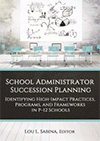
School Administrator Succession Planning
Identifying High-Impact Practices, Programs, and Frameworks in P-12 Schools
Edited by:
Lou L. Sabina, Stetson University
Published 2023
Across the United States and globally, school districts are regularly facing a shortage of both willing and highly qualified candidates to assume positions as school leaders. A number of factors have contributed to this shortage including but not limited to: (1) retiring baby boomers leaving P-12 schools (ex. Aaronson & Meckel, 2009; Carlson, 2004; Parylo & Zepeda, 2015; Wiedmer, 2015), (2) shifting demographics and population changes across the United States workforce and schools (ex. Betts, Urias, & Betts, 2009; Brimley, Garfield, & Verstegen, 2005; Brown, 2016; Miller & Martin, 2015; Mordechay & Orfield, 2017), (3) increasing demands for school administrators making the position less desirable (ex. Grissom, Loeb, & Mitani, 2015; Lortie, 2009; Norton, 2002; Yan, 2019), and (4) the shift of schools to 21st Century Learning centers, which have changed the role of school administrators (ex. Crow, Hausman, & Scribner, 2002; Huber, 2014). According to the National Bureau of Labor Statistics, the current demand for school principals continues to increase (Occupational Outlook Handbook, 2019) and will accelerate in the coming 10-20 years. Because of the high need for school administrators, many schools and school districts are creating unique, targeted, and innovative programs to find principals who can meet the changing needs in our school system.
CONTENTS
School Leadership Succession Planning for the 21st Century and Beyond, Lou L. Sabina. Planning a Pathway to Leadership Development: One School System’s Story, Brenda Mendiola, Yvette Bynum, and Richjetta Branch. A Different Approach to Succession: Promoting Sustainable School Leadership Through Effective Principal-Teacher Relationships, Jentre J. Olsen. Scholarship Versus Practice: Best Succession Planning Practices From Scholarship as Compared With Practices Employed by a Large Outer-Ring Suburban School District in the Field, David G. Buckman and Henry Tran. The Role of Principal Supervisors in Supporting Succession Practices, Amie B. Cieminski. Filling the Breach: New Superintendent Induction in the Absence of Succession Planning, Robb Smith and W. Kyle Ingle. Distributed Articulation: Blurring the Line Between District and Higher Education to Grow School Leadership, Adrianne G. Wilson, Gina Almerico, and Tony Erben. Partnerships and Pathways: Strategic Approaches to Academic Succession Planning for Leadership, Kristine Y. Hogarty, Joyce G. Haines, and Gloria Waite. Assessing Succession-Planning Processes: A Case Study for Improvement, Christopher M. Parfitt and Brianne M. Romano. Out With the Old, in With Who: How Two Rural School Districts Focused on Succession Planning, Jarett Powers and Terry Ward. Holding It Together: Using the Holding Environment Concept to Support the Adaptive Change Experience of Principal Succession, Jeffrey Hartmann. Leadership Succession Is More About the Who and the Why Than the How: An Analysis of Succession Planning Through an Ethical and Moral Lens, Dan Compagnon and Max Vecchiarino. About the Authors.
-
Paperback978-1-64802-929-5
Web price: $45.04 (Reg. 52.99)
-
Hardcover978-1-64802-930-1
Web price: $80.74 (Reg. 94.99)
- eBook978-1-64802-931-8

- EDU032000 - EDUCATION: Leadership
- EDU001040 - EDUCATION: ADMINISTRATION: School Superintendents & Principals
- BUS071000 - BUSINESS & ECONOMICS: Leadership
-
 Catalytic Improvement Communities
Cultivating Flourishing Schools
Catalytic Improvement Communities
Cultivating Flourishing Schools
-
 Compassionate Leadership for School Improvement and Renewal
Compassionate Leadership for School Improvement and Renewal
-
 Dark and Destructive Leadership
Dark and Destructive Leadership
-
 Faculty Peer Coaching in Higher Education
Opportunities, Explorations, and Research from the Field
Faculty Peer Coaching in Higher Education
Opportunities, Explorations, and Research from the Field
-
 Polling Student Voices for School Improvement
A Guide for Educational Leaders - 2nd Edition
Polling Student Voices for School Improvement
A Guide for Educational Leaders - 2nd Edition
-
 Supporting Leaders for School Improvement Through Self-Care and Wellbeing
Supporting Leaders for School Improvement Through Self-Care and Wellbeing
-
 The Handbook for Aspiring Higher Education Leaders
The Handbook for Aspiring Higher Education Leaders

